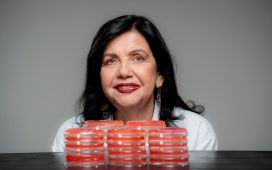Belgian physicist and musician Prof Bob Coecke, 55, wants to teach quantum physics to a mass audience. The paradox-filled theory that describes the microscopic realm has become a staple of science fiction, from Marvel’s Ant-Man to the multiple Oscar-winning Everything Everywhere All at Once. It’s famously bizarre and, in the UK, the subject is mostly reserved for undergraduates specialising in physics because it requires grappling with complicated maths. But Coecke, a former Oxford professor, has devised a maths-free framework using diagrams for total beginners, outlined in Quantum in Pictures, his book with Dr Stefano Gogioso that was published earlier this year. Over the summer, they ran an education experiment, teaching the pictorial method to UK schoolchildren – who then beat the average exam scores of Oxford University’s postgraduate physics students.
Quantum physics is notoriously esoteric. Why should most people even want to study it?
Think about AI. Think about how the world is getting fucked up now. Billion-dollar companies are in charge of a revolution that could control the world and nobody understands what they are doing. I used to be an Oxford professor for 20 years and now I work in industry, with Quantinuum, building quantum computers [machines designed to exploit subatomic physics to one day outperform conventional computers]. We want people to understand what we’re doing from the start, before the technology becomes huge. We want to make Stem [science, technology, engineering and mathematics] more inclusive, make quantum more inclusive. It’s completely counterintuitive, but within industry I can now do this educational experiment.
Your educational experiment involved 54 schoolchildren, aged 15-17, who were randomly selected from around 1,000 applicants, from 36 UK schools – mostly state schools. The teenagers spent two hours a week in online classes and after eight weeks were given a test using questions from an Oxford postgraduate quantum physics exam. More than 80% of the pupils passed and around half earned a distinction. Were you surprised by their success?
At one point, I was going to call off the whole thing because I thought it was going to be a complete disaster. We’d originally wanted the kids to interact with each other on social media or communicate online, but that wasn’t allowed due to the ethical guidelines for the experiment. I thought, what sort of educational experience is it, if you can’t talk to each other?
This is the Covid generation: none of them put their cameras on [for the online classes], so we were looking at a black screen. None of them asked questions using their voices, they just typed. It was a difficult teaching challenge by all standards. We also saw a self-esteem problem with the students. But the majority of kids liked that we had announced that you didn’t need a complex maths background. The maths had been a barrier to kids who had wanted to access this knowledge.
And then we got back the numbers. They did significantly better than we see from university-level students. Exams were marked blind, so we don’t know how many came in with the aim of pursuing Stem. We are processing that data now.
How did you come up with this ‘quantum picturalism’ method? Was it originally aimed at children and beginners?
I’m a very visual person. I’m not just a quantum physicist, I’m an artist and musician. In fact, the only reason I ended up in quantum physics was because I wanted to support my music career – my rock/metal/electronica fusion band, Black Tish, released two albums this year. I got a job at Oxford University’s computer science department in the 1990s and my senior colleague Samson Abramsky told me we needed a high-level programming language for [future] quantum computers. For normal computing, you program in zeros and ones, but most people don’t understand how to do that. But everyone understands how to use an iPhone. We wanted the equivalent of an iPhone interface for quantum-computer programming. So Abramsky and I published a new formalism of quantum mechanics in 2004, based on “category theory” [a well-established branch of mathematics that uses diagrams to describe collections of objects].
I then developed it over the years, with others, and I wrote a book about it for physicists in 2017 with Aleks Kissinger. But the worst people to teach are theoretical physicists. They have so much to unlearn. Half of the mainstream people in quantum computing said: “You are doing things with silly pictures, this can’t be useful, it is too simple!” And the other half said: “Category theory is so hard, this can’t be useful, it is too complicated!” It took years to get rid of the stigma that this was too complicated. So I wrote this new book with Stefano, who did all the pictures, specifically to run this experiment, to prove that this is so easy, kids can do it and outperform Oxford postgrad students.
We hear so many weird and wonderful things about quantum physics: A cat in a box can be dead and alive at the same time, until you look at it; particles can be in two places at once, unless their position is measured; information can be “teleported” between quantum systems. How do you convey these processes using just pictures?
It’s simple. It’s all drawing quantum circuits: boxes connected by wires [to demonstrate quantum phenomena]. Teleporting is just sliding boxes along a wire. Measurements are represented by boxes called “spiders” that have many legs, or wires, sticking out. A quantum particle that can be in two places at once before being measured is drawn as two legs that go into a spider – the spider’s body represents the measurement – and there’s one leg coming out the other side, that’s the outcome.
What is your hope for quantum picturalism in the future?
I have been approached by people in the Australian and Greek governments, in their education departments, who are interested in implementing this. I am also passionate about taking this into Africa. It’s early days, but we are planning something there.
I started out wanting to change the way quantum mechanics is understood, and it’s easier to convince kids than adults. They have no preconceptions. So maybe the next generation will carry it forward. As one of the founders of quantum physics, Max Planck, once said: “Science advances one funeral at a time.”










